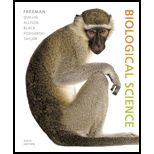
Introduction:
Hormones are the chemical compounds found in plants and animals with different chemical and structural formulas. In animals, hormones are secreted by either endocrine or exocrine glands. These are present at different locations. Steroid hormones are of two types in animals—sex steroids and corticosteroids. Steroid hormones are long-term hormones: they are in the system for a longer period of time as compared to the other kinds of hormones.
Answer to Problem 1TYK
Correct answer:
Steroid hormones being lipid soluble can easily pass through plasma membrane (a lipid bilayer). The receptors for lipid soluble hormones exist inside the cell.
Explanation of Solution
Explanation/Justification for the correct answer:
Option (a) is given as steroid hormones being lipid soluble can cross the plasma membrane. Animal hormones are mostly amino acid derivatives, steroids, or polypeptides. Steroid hormones belong to the category of lipid-soluble hormones. They have a lipid nature, which makes it easier for them to be transported across the cell membranes and bind to receptors located in the membranes of target cells. Hence, option (a) is correct.
Explanation for incorrect answer:
Option (b) is given as that amino acid derived and polypeptide hormones are longer lived and have a greater signal amplification. However, it is the steroid hormone, which lasts longer in the circulation as compared to the given hormones in the option. So, it is a wrong answer.
Option (c) is given as that complexity of polypeptide hormones is more than steroid hormones and they induce permanent change. Polypeptide or protein hormones are short-acting in nature. Steroid hormones have a longer life period than polypeptide hormones. The complexity does not define the effect of any hormone. The effects of these hormones are not permanent. So, it is a wrong answer.
Option (d) is given as that it is the steroid hormones alone can bind to the receptors in cell surface. Polypeptide hormones are the ones that usually bind to the cell surface. Polypeptide hormones after binding to the cell surface receptors initiate a cascade of secondary reactions. The receptors for steroid hormones can be in the cytoplasm, cell membrane, or intranuclear. So, it is a wrong answer.
Hence, options (b), (c), and (d) are incorrect.
Steroid hormones are known to act by binding to intracellular receptors. These receptors can be inside the nucleus also. The ability to cross plasma membrane is due to hydrophobic nature of both steroid hormones and plasma membrane.
Want to see more full solutions like this?
- Molecular Biology Question A gene that codes for a protein was removed from a eukaryotic cell and inserted into a prokaryotic cell. Although the gene was successfully transcribed and translated, it produced a different protein than it produced in the eukaryotic cell. What is the most likely explanation?arrow_forwardMolecular Biology LIST three characteristics of origins of replicationarrow_forwardMolecular Biology Question Please help. Thank you For E coli DNA polymerase III, give the structure and function of the b-clamp sub-complex. Describe how the structure of this sub-complex is important for it’s function.arrow_forward
- Molecular Biology LIST three characteristics of DNA Polymerasesarrow_forwardMolecular Biology RNA polymerase core enzyme structure contains what subunits? To form holo enzyme, sigma factor is added to core. What is the name of the structure formed? Give the detailed structure of sigma factor and the function of eachdomain. Please help. Thank youarrow_forwardMolecular Biology You have a single bacterial cell whose DNA is labelled with radioactiveC14. After 5 rounds of cell division, how may cells will contain radioactive DNA? Please help. Thank youarrow_forward
- 1. Explain the structure and properties of atoms and chemical bonds (especially how they relate to DNA and proteins). Also add some pictures.arrow_forward1. In the Sentinel Cell DNA integrity is preserved through nanoscopic helicase-coordinated repair, while lipids in the membrane are fortified to resist environmental mutagens. also provide pictures for this question.arrow_forwardExplain the structure and properties of atoms and chemical bonds (especially how they relate to DNA and proteins). Also add some pictures.arrow_forward
- In the Sentinel Cell DNA integrity is preserved through nanoscopic helicase-coordinated repair, while lipids in the membrane are fortified to resist environmental mutagens. also provide pictures for this question.arrow_forward1. Explain how genetic information is stored, copied, transferred, and expressed. Also add some pictures for this question.arrow_forward!. Describe biological macromolecules (DNA, RNA, proteins, lipids, etc.) and how they function in the cell. also provide some images for this question.arrow_forward
 Human Physiology: From Cells to Systems (MindTap ...BiologyISBN:9781285866932Author:Lauralee SherwoodPublisher:Cengage Learning
Human Physiology: From Cells to Systems (MindTap ...BiologyISBN:9781285866932Author:Lauralee SherwoodPublisher:Cengage Learning Biology (MindTap Course List)BiologyISBN:9781337392938Author:Eldra Solomon, Charles Martin, Diana W. Martin, Linda R. BergPublisher:Cengage Learning
Biology (MindTap Course List)BiologyISBN:9781337392938Author:Eldra Solomon, Charles Martin, Diana W. Martin, Linda R. BergPublisher:Cengage Learning Concepts of BiologyBiologyISBN:9781938168116Author:Samantha Fowler, Rebecca Roush, James WisePublisher:OpenStax College
Concepts of BiologyBiologyISBN:9781938168116Author:Samantha Fowler, Rebecca Roush, James WisePublisher:OpenStax College Anatomy & PhysiologyBiologyISBN:9781938168130Author:Kelly A. Young, James A. Wise, Peter DeSaix, Dean H. Kruse, Brandon Poe, Eddie Johnson, Jody E. Johnson, Oksana Korol, J. Gordon Betts, Mark WomblePublisher:OpenStax College
Anatomy & PhysiologyBiologyISBN:9781938168130Author:Kelly A. Young, James A. Wise, Peter DeSaix, Dean H. Kruse, Brandon Poe, Eddie Johnson, Jody E. Johnson, Oksana Korol, J. Gordon Betts, Mark WomblePublisher:OpenStax College Human Biology (MindTap Course List)BiologyISBN:9781305112100Author:Cecie Starr, Beverly McMillanPublisher:Cengage Learning
Human Biology (MindTap Course List)BiologyISBN:9781305112100Author:Cecie Starr, Beverly McMillanPublisher:Cengage Learning





